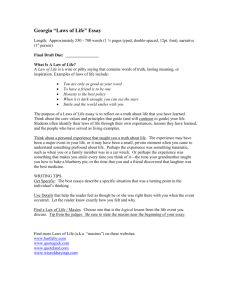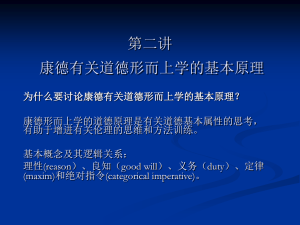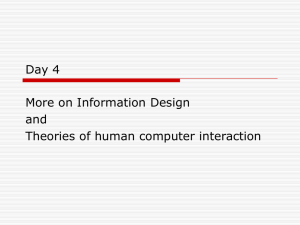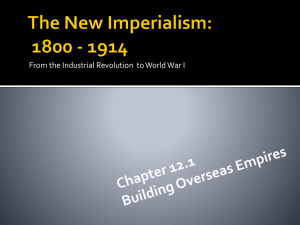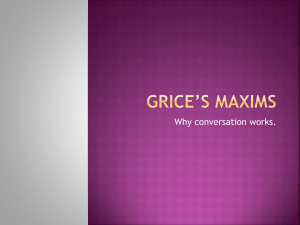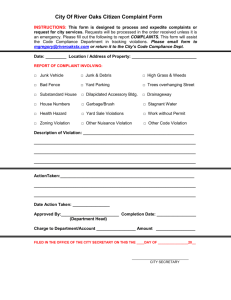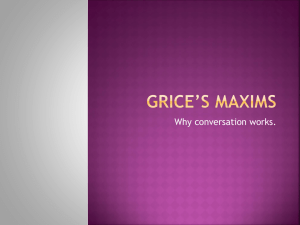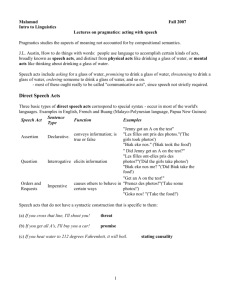2. Figures of Speech Created by Violation of the Maxim of Quantity
advertisement
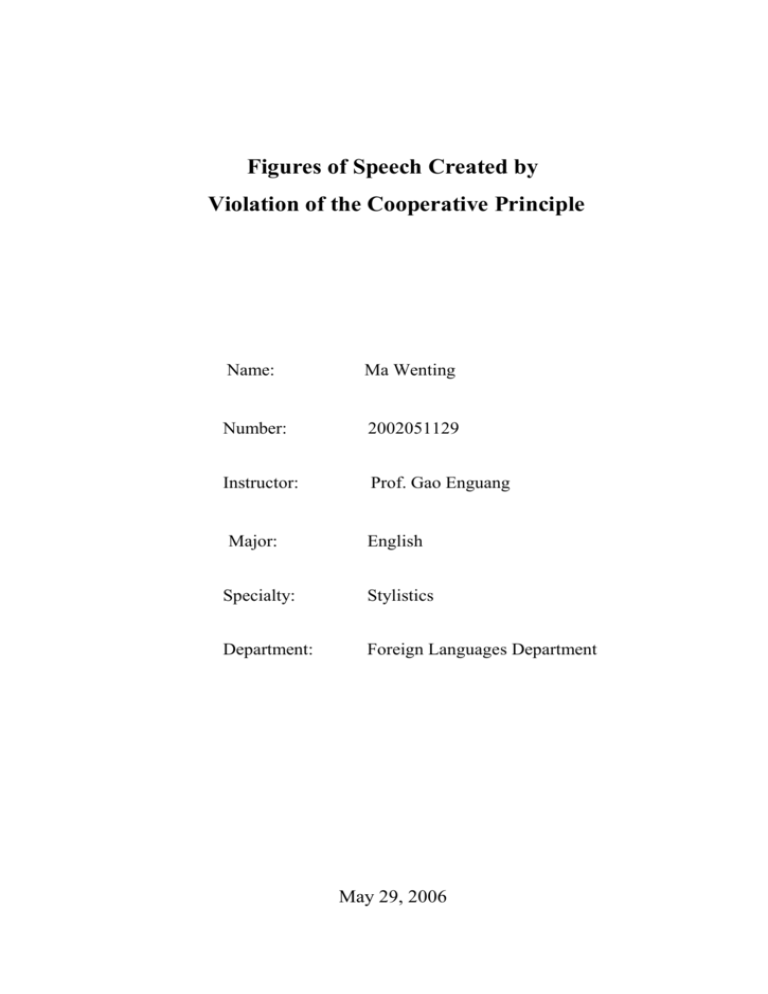
Figures of Speech Created by Violation of the Cooperative Principle Name: Ma Wenting Number: 2002051129 Instructor: Prof. Gao Enguang Major: English Specialty: Stylistics Department: Foreign Languages Department May 29, 2006 Ma Wenting Figures of Speech Created by violation of the Cooperative Principle Thesis statement: Violation of the Cooperative Principle, namely, the maxims of quantity, of quality, of manner, and of relation, can create many figures of speech in prose and in our daily conversations. Outline: 1. Introduction 2. Figures of Speech Created by Violation of the Maxim of Quantity 2.1 Tautology 2.2 Simile 3. Figures of Speech Created by Violation of the Maxim of Quality 3.1 Irony 3.2 Metaphor 3.3 Meiosis 3.4 Hyperbole 3.5 Oxymoron 3.6 Paradox 4. Figures of Speech Created by Violation of the Maxim of Manner. 4.1 Figures of Speech Created by Violation of the First Maxim of Manner 4.1.1 Metonymy 4.1.2 Synecdoche 4.1.3 Euphemism 4.2 Figures of Speech Created by Violation of the Second Maxim of Manner 4.2.1 Ambiguity 4.2.2 Pun 4.3 Figures of Speech Created by Violation of the Third Maxim of Manner 4.3.1 Pleonasm 4.3.2 Circumlocution 4.4 Hysteron-proteron Created by Violation of the Fourth Maxim of Manner 5. A Figure of Speech Created by Violation of the Maxim of Relation 6. Conclusion: 2 Ma Wenting Figures of Speech Created by Violation of the Cooperative Principle Ma Wenting (Foreign Languages Department, Taiyuan Normal University, Taiyuan, 030012, China) Abstract: The Cooperative Principle, an important theory in pragmatics, is put forward by the Oxford philosopher Herbert Paul Grice. It can be applied to explaining many phenomena concerning the language use. One of the most interesting application lies in its explanation of the creation of many figures of speech. This paper tries to discuss the figures of speech produced by violation of the four maxims of the cooperative principle, namely, the maxim of quantity, of quality, of manner, and of relation. Key words: cooperative principle; figure of speech; violation 违反合作原则产生的修辞格 马文婷 (太原师范学院外语系, 山西, 太原, 030012) 摘要:合作原则由牛津大学 H.P.格赖斯教授提出,是应用语言学领域至关重要的理论。它可以用来解 释许多关于语言使用方面的现象。其中最有趣的莫过于它在解释修辞格方面的应用。本文试图阐释违 反合作原则中四条准则产生的各种修辞格。 关键词:合作原则; 修辞效果; 违反 3 Ma Wenting Ma Wenting English 2002051129 Professor Gao May 29, 2006 Figures of Speech Created by Violation of the Cooperative Principle 1. Introduction Herbert Paul Grice, though a philosopher at Oxford, has made a great contribution to linguistics; specifically, to pragmatics. In 1967, he surprised the philologists around the world by advancing his Cooperative Principle. Later on, his theory was accepted gradually and the research in this aspect continues on. The study, however, has not yet been applied to rhetoric, also an old subject studying the language in use. Hu Fanzhu (Internet) states in his paper as well that even though both rhetoric and pragmatics focus on the study of the language in use, they have long been separated from each other. Actually, only by employing the Cooperative Principle can we, to some extent, realize the integration of the two. The violation of the Cooperative Principle, namely, the maxim of quantity, of quality, of manner, and of relation, can create many figures of speech in prose and in our daily conversations. The Cooperative Principle was proposed at the William James lectures given by H.P. Grice at Harvard in 1967. And not until eight years later was part of it published under the title of “Logic and Conversation”. In the book, Grice expounded his Cooperative Principle in great detail. He believed that “ there is some regularity in conversation”(Hu Zhuanglin& Jiang Wangqi,2001:253). That is to say, when we carrying on our conversation, we tend to follow the principle: “ Make your conversational contribution such as is required, at the stage at which it occurs, by the accepted purpose or direction of the talk exchange on which you are engaged”(qtd. in Liu Runqing, et al: 517). This principle is the Cooperative Principle. Specifically, it includes 4 maxims,i.e., the maxim of quantity, of quality, of manner, and of relation. In daily communication, however, people do not strictly follow these maxims. They may consciously violate the Cooperative Principle, and by doing so, some rhetorical effect can be achieved. Especially, some figures of speech are the results produced by violation of the maxims of the Cooperative Principle. 2. Figures of Speech Created by Violation of the Maxim of Quantity Grice expounds his maxim of quantity as follows: 4 Ma Wenting The category of QUANTITY relates to the quantity of information to be provided, and under it fall the following maxims: 1.Make your contribution as informative as is required ( for the current purposes of the exchange). 2.Do not make your contribution more informative than is required. (qtd. in Liu Runqing, et al :517) Violation of the two sub-maxims will produce the following figures of speech: 2.1 Tautology Created by Violation of the First Maxim of Quantity Let us first consider a sentence: (1) Facts are facts. No new information is passed from the speaker to the listener by this sentence, since there is only one content word. According to Grice, this sentence violates the first maxim of quantity. Actually, at the same time, a figure of speech is created. It is tautology. It is defined in A Dictionary of Western Stylistics (Hu Zhuanglin& Liu Shisheng, 2004:319) as an abnormal phenomenon in rhetoric. To be more specific, the argument or proposition of a sentence is repeated by the same word or word with similar meaning. Here is another example: (2) Women are women. In this sentence, two words out of three are the same: “women”. Superficially, no new information is provided. Yet, reading more carefully, we understand what the writer intends to say is that women have some features belonging exclusively to them. Instead of saying this directly, the speaker consciously violates the first maxim of quantity for the effect of humor and emphasis. 2.2 Simile Created by Violation of the Second Maxim of Quantity According to Grice’s second maxim of quantity, our speech to the interlocutor should be no more than what is required by the listener. Nevertheless, simile tells more than the listener’s requirement. It provides additional information about one element by employing a phrase with “as” or “like” plus another unlike element having at least one quality or characteristic in common with the former element. Look at the following sentence: (3) And then the whining schoolboy, with his satchel and shining morning face, creeping like snail unwillingly to school… ( W. Shakespeare: As You Like It) Instead of saying that the boy walks slowly, which is the fact needed by the reader, Shakespeare portrays it as “creeping like snail”. This is the additional information that makes example (3) against the second maxim of quantity, and meanwhile, results in the creation of simile. But in this way, he describes the image more vividly. 3. Figures of Speech Created by Violation of the Maxim of Quality As is the same with the maxim of quantity, Grice explains his maxim of quality also in two aspects: Under the category of QUALITY falls a supermaxim― ‘Try to make your contribution one that is 5 Ma Wenting true’―and two more specific maxims: 1.Do not say what you believe to be false. 2.Do not say that for which you lack adequate evidence. (qtd. in Liu Runqing, et al:517) The figures of speech concerning violation of the second maxim of quality are not easy to find. The discussion concentrates on those created by violation of the first maxim of quality. In his book Modern Pragmatics (2003), Jiang Wangqi says that all the examples Grice used to illustrate violation of the first maxim of quality are the traditional figures of speech. And in “Logic and Conversation”, Grice himself gives some examples of irony, metaphor, meiosis, and hyperbole. After my own research, I believe that oxymoron and paradox are cause by violation of this maxim as well. 3.1 Irony “Irony is a figure of speech that achieves emphasis by saying the opposite of what is meant, the intended meaning of the words being the opposite of their usual sense.”(Feng Cuihua,2005:228) Thus, it is given rise to by violation of the first maxim of quality. Grice illustrates this point in his “Logic and Conversation” by the following example: (4) X, with whom A has been on close terms until now, has betrayed a secret of A’s to a business rival, A and his audience both know this. A says, “X is a fine friend ”.(…) (Jiang Wangqi,2000:48) Let’s see another passage which proves this point even more forcefully: (5) It is a very justifiable cause of war to invade a country after the people have been wasted by famine, destroyed by pestilence, or embroiled by factious among themselves. It is justifiable to enter into war against our nearest ally, when one of his towns lies convenient for us, or a territory of land, that would render our dominions round and complete. If a prince sends forces into a nation where the people are poor and ignorant, he may lawfully put half of them to death, and make slaves of the rest, in order to civilize and reduce them from their barbarous way of living. (Jonathan Swift: Travels) With full attention, we can feel the tone of irony throughout the whole passage. What is said to be “justifiable” and “lawful” is actually “unjustifiable” and “unlawful”. In this way, even though he does not state fact, Swift strongly satirizes the war. 3.2 Metaphor Metaphor, like simile, also makes comparison between two unlike elements; but this comparison is not stated but implied. Speaking from the pragmatic point of view, metaphor is created by violation of the first maxim of quality. Let’s read two sentences here: (6) You are the cream in my coffee. (7) All the world’s a stage, 6 Ma Wenting (W. Shakespeare: As You Like It) Example (6) is the most clever expression in talking about one’s importance to someone else. But, Grice argues that it “characteristically involve(s) categorical falsity”, regarding two things of different nature as the same. It goes without saying that “you” is a highly intelligent creature, while “cream” is just a kind of liquid. As for (7), it is also brought about by the violation of this maxim because Shakespeare obviously committed a categorical falsity by rendering “the world” as “a stage” which are of course not the same thing at all. 3.3 Meiosis Meiosis, also named litotes, achieves its effect of emphasis by “a discounting way of saying”. For instance: (8) “ Well… Let’s go home and talk about it. We’ll figure out something. I can send you to the employment office I went to and— ” “I can’t type. I got no college degree. I can’t do anything— and besides, I wanna be in the show!” Neely started to sob violently again. “Please, Neely,” Anne begged. She knew Miss Steinberg and the girls were staring, but her worst fear materialized when Lyon Burke opened his door. She smiled at him weakly as he came over and stared at the shrieking Neely. “This is Neely. She’s a little upset.” “I’d say that was a classic understatement.” (Susanna: Valley of the Dolls) From the above narration, we know that Neely is extremely upset. When Lyon Burke appeared, however, Anne “discounts” the degree of Neely’s unhappiness and said she is only “a little upset”. This betrays the fact apparently. Therefore, we say meiosis is the result of the violation of the first maxim of quality. And by this way, Anne’s character is fully displayed. 3.4 Hyperbole “Hyperbole is the deliberate use of overstatement or exaggeration to achieve emphasis”.(Feng Cuihua, 2005:212). It is produced by violation of the first maxim of quality for the simple reason that the sentence containing it does not state a fact, but an exaggeration of the fact. (9) For she was beautiful— her beauty made The bright world dim, and everything beside Seemed like the fleeting image of a shade. (P.B. Shelley: The Witch of Atlas) No matter how beautiful one is, the beauty cannot make “the bright world dim”. The poet obviously overstates the power of “her” beauty for emphasis. 3.5 Oxymoron 7 Ma Wenting Oxymoron, originated from Greek, is formed “by the conjoining of two contrasting, contradictory or incongruous terms.”(ibid.:209) Let’s look at two classical examples: (10) I have a jolly wo, a lusty sorrow.” (Chaucer: Troilus and Criseydy.) (11) Why, then, O brawling love, O loving hate, O any thing! Of nothing first create, O heavy lightness! Serious vanity! Mis-shapen chao of well-seeming forms! Feather of lead, bright smoke, cold fire, sick health! (W. Shakespeare: Romeo and Juliet) “Wo” in example (10) is by definition something bitter and hard, which cannot be “jolly” at all; similarly, “sorrow” is something sad and melancholy, which cannot be “lusty”. This effect of emphasis, intended by the author’s deliberate arrangement of these contrasting noun phrases, is achieved by the clear deviation from the fact. Oxymoron runs throughout the whole of example (11). Nearly every content word forms an oxymoron with the one following it. This makes Shakespeare go against the first maxim of quality. Yet, Romeo’s conflicted feeling is shown much more lively. 3.6 Paradox Paradox is and expanded version of oxymoron. That is to say, it forms contradictory idea in one sentence, not in two successive words. For instance, “War is peace, Freedom is slavery.” This figure of speech exists as the by-product of the violation of the first maxim of quality. Donne writes in his Holly Sonnet 14 as: (12) For I Except you enthrall me, never shall be free, Nor ever chaste, except you ravish me. Based on our common sense we know, if one is “enthralled”, he would never be “free”; if one is “ravished”, he would never be “chaste”. Of course, Donne is not so foolish as to refer to someone “enthralled” as “free”, someone “ravished” as “chaste”. He deliberately says something he believes, and everybody believes, to be untrue to call the readers’ attention and to emphasize his love toward God. 4. Figures of Speech Created by Violation of the Maxim of Manner. Grice put his maxim of manner in this way: Finally, under the category of MANNER, which I understand as relating not (like the previous categories) to what is said but, rather, to HOW what is to be said, I include the supermaxim—‘Be perspicuous’ —and various maxims such as: 1.Avoid obscurity of expression. 8 Ma Wenting 2.Avoid ambiguity. 3.Be brief.( avoid unnecessary prolixity) 4.Be orderly. (qtd. in Liu Runqing, et al: 518) Figures of speech can be found concerning the first three sub-maxims. Nonetheless, “ Grice did not give any example of disorder, which is understandable in that generally a disordered utterance will not convey anything but the fact that the speaker is mentally unsound”.(Hu Zhuanglin& Jiang Wangqi,2001:258) However, in rhetoric, this is not absolutely true. We can still find some examples. 4.1 Figures of Speech Created by Violation of the First Maxim of Manner 4.1.1 Metonymy The first maxim of manner, avoiding obscurity of expression, provides that everything should be stated explicitly. For instance, when we want to refer to the ice-cream, we should simply pronounce “ice-cream”, not “I—C—E—C—R—E—A—M”. But, metonymy is realized just by violating this maxim. “Metonymy is a figure of speech that has to do with the substitution of the name of one thing for that of another”.(Feng Cuihua,2005:195) To put it plainly, metonymy is to denote something only by referring to a feature of it. This would make the reader confused about what it is talking about. Read the following passage: (13) The glories of our blood and state Are shadows, not substantial things; There is no armour against fate; Death lays his icy hand on kings; Scepter and Crown Must tumble down And in the dust be equal made With the poor crooked scythe and spade (J. Shirley: Death the Leveller) The first reading may leave the reader in the dark: what on earth do “scepter”, “crown”, “scythe”, and “ spade” mean? Obviously, their bafflement comes form the violation of the first maxim of manner. If Shirley states bluntly the four as “king”, “queen”, “peasants”, and “workers of the land”, the whole suspence on part of the readers would be got rid of. 4.1.2 Synecdoche Synecdoche is also the consequence of violating the first maxim of manner, as is the case for metonymy. But, instead of denoting something by referring to a feature of it, synecdoche involves “substitution of the part for the whole, or the whole for the part.”(ibid.:199) For the first category, let’s see Edward Fitzgerald’s line: (14) Alas, the Spring should vanish with the Rose! 9 Ma Wenting The “Rose”, in fact, refers to flowers in general. However, it is difficult for the readers to get this understanding, and even if they do, they do have to use logic thinking and reasoning, and spend some time on it. As for the second category, we can easily find examples in the report of sports games, such as the sentence: (15) China defeated America at football. Without the background knowledge, the listener would be totally confused about its meaning. Suppose that the reporter had reported: “The Chinese football team defeated the American team” at the expense of economy, which does not violate any maxim, the listener would be quite clear. 4.1.3 Euphemism Euphemism is defined in the Third Edition of the New Words Supplement Longman Dictionary of Contemporary English (2001) as “a polite word or expression that you use instead of a more direct one to avoid shocking or upsetting someone.” The commonest example is to say “pass away” instead of the direct and unpleasant expression “die”. By means of euphemism, one’s speech becomes more pleasant. But meanwhile, a great challenge is posed on the listener. For someone with no knowledge about euphemism specifically belonging to certain culture, it would be impossible for him to figure out what on hell the speaker is talking about. Thus, we come to the conclusion that euphemism if produce by the speaker’s conscious violation of the first maxim of manner. Sometimes, people tend to adopt euphemism in essay-writing to show their feelings to a great extent, such as in the following passage: (16) On the 14th of March, at a quarter to three in the afternoon, the greatest living thinker ceased to think. He had been left alone for scarcely two minutes, and when we came back we found him in his armchair, peacefully gone to sleep— but forever. (Frederick Engels: Speech at the Graveside of Karl Marx) The two phrases “ceased to think” and “gone to sleep” are the euphemism for “die”. Engels, the deliverer who made this speech at the graveside of Karl Marx, did not want to say Marx’s death directly. That’s why he chose the indirect expressions and in this way, he showed his great mourn over Marx’s death. Nevertheless, for those without the background knowledge about the delivery of this speech, it would be easy for them to take the literal meaning of these phrases and their communication would break down. 4.2 Figures of Speech Created by Violation of the Second Maxim of Manner 4.2.1 Pun Pun is a play on words. It makes use of the form and meaning of words for humor. However, sentences containing pun are difficult for reader to work out their real meaning. They always face the question: which meaning to decide on among two or three or even more meanings of a word or a phrase? The speaker is free to select a clearer expression, and obey the second maxim of manner— to avoid ambiguity. But if so, the humorous effect would be lost. Grice discussed this aspect with William Blake’s line: 10 Ma Wenting (17) Never seek to tell thy love, love that never told can be. The first “love” in this line may refer to the abstract emotion— affectation between two people; or the concrete creature: the one whom the other loves. The latter part of the line “love that never told can be” may mean “one’s love is so profound that one cannot express it fully”, or “love will not be love if it is told”. Which one is Blake’s intended meaning? Maybe the former, the latter, or both. You can never tell. How the reader would expect that Blake has not violated the maxim of ambiguity and said things directly! However, for the simple reason of maintaining the literary effect, Blake decided to violate the maxim. 4.2.2 Ambiguity We know from the name of this figure of speech that it is realized certainly by violation of the second maxim of manner. In prose, the usage of ambiguity can create a humorous effect, and meanwhile arouse the readers’ imagination. (18) The Clerk: Are you engaged? Augustus: What business is that of yours? However, if you will take the trouble to read the society papers for this week, you will see that I am engaged to the Honorable Lucy Popham, youngest daughter of — The Clerk: That isn’t what I mean. Can you see a female? Augustus: Of course, I can see a female as easily as a male. Do you suppose I’m blind? The Clerk: You don’t seem to follow me, somehow. There’s a female downstairs: what you might call a lady. She wants to know can you see her if I let her up. (George Bernard Show: Augustus Does His Bit) “Are you engaged” can be comprehended in two ways: “Are you busy now?” and “Have you promised to marry someone?” The clerk originally means the first understanding, yet Augustus misunderstood him by taking the second. Similarly, “see” may mean “meet someone” or “ to be about to use one’s eyes to look at things and know what they are”. Again Augustus mistook the latter for the former. As a matter of fact, the clerk can choose a more direct expression, such as “are you busy?” or “can you meet a lady downstairs?” But he decided on a rather ambiguous one to achieve a humorous effect. 4.3 Figures of Speech Created by Violation of the Third Maxim of Manner 4.3.1 Pleonasm Grice believes that in our daily conversation we should use the fewest words to express the clearest meaning. If one word will do, it would violate the third maxim of manner by using two. One figure of speech, nonetheless, just requires us to do the contrary. It is pleonasm, the technical term in rhetoric for “redundancy’. And it is defined in the Routledge Dictionary of Language and Linguistics as “the addition of a superfluous expression which is already included in that which is said, e.g. three a. m. in the morning”. In other words, a sentence involving pleonasm is one in which a word is repeated: (19) It was mirk, mirk night, there was nae starlight. 11 Ma Wenting They waded thro’ red blude to the knee… (Thomas Rhyme) In this example, one “mirk” is enough to describe the night, yet Thomas Rhyme here intentionally repeats it. This violation helps him to attain his purpose for emphasis. 4.3.2 Circumlocution Circumlocution is to express an idea in a roundabout way. A sentence with circumlocution is unusually longer than the usual one which extends the same meaning. This abnormality is the consequence of the violation of the third maxim of manner. Here is an example: (20) Macbeth…. And pity, like a naked new-born babe, Striding the blast, or heaven’s cherubin, hors’d Upon the sightless couriers of the air, Shall blow the horrid deed in every eye. That tears shall drown the wind… (William Shakespeare: Macbeth) At the first reading, the reader would know at once what “the sightless couriers of the air” means. It is “wind”. Shakespeare could say “wind” straightforwardly, but he uses circumlocution. Through this figure of speech, he makes the structure fat and redundant in order to realize a humorous effect. 4.4 Hysteron-proteron Created by Violation of the Fourth Maxim of Manner The fourth maxim of manner by Grice stipulates that everything spoken or written should be logical. And both Hu Zhuanglin (2001: 258) and Jiang Wangqi (2003:67) all give the Chinese example “屡败屡战”( have repeatedly failed and fought),arguing that it violates this maxim since only “战” can result in “败”. They argued as well that if one’s talk violates the maxim of order, it shows nothing but that the man is mentally unsound. However, the figure of speech “hysteron-proteron” is just produced by the violation of this maxim. It is a device which reverses the logical order of various concepts on purpose. Here are two examples: (21) He put on his shoes and stockings. (22) Let us die, and rush into the midst of the fray. (Virgil: Aeneid) Example (21) violates the maxim of order because it would be ridiculous for a normal person to first “put on the shoes” and then “stockings”. Though Hu Zhuanglin and Jiang Wangqi said the two sentences “They got married and then had a baby” and “They had a baby and then got married” do not violate the maxim for they are expressed in their own ways based on the living convention, example (21) is not the same, except that one puts his stockings out of the shoes. Example (22) is more interesting than (21). One who has died cannot, of course, “rush into the midst of the 12 Ma Wenting fray”. He can only lie in his eternal bed. The right order must be “let us rush into the midst of the fray, and die”. This seemingly irrationality on part of Virgil just emphasizes his unwavering determination. 5. A Figure of Speech Created by the Violation of the Maxim of Relation According to Grice, in order to carry on a conversation, the listener’s speech should be relevant to the speaker’s, and vice versa. The figure of speech which is created by violation this maxim is rare, but there still can be found one: ploce. It is a rhetorical device which repeats the same word with the meaning being a little bit modified. (23) Luan Ping: Aha! What a daring “Hu Biao” you are! How dare you— Yang Zirong: Of course, I dare to ask you is it my fault or your fault! ( The situation is that Luan Ping detected that Yang Zirong was disguising himself as Hu Biao, and intended to report it.) (Xie Tieli: 智取威虎山) (24) Lao Guai put a piece of watermelon at his wife’s mouth and said: “ Have a try! It’s sweet!” His wife didn’t pick it with her own hand, but bit it from Lao Guai’s hand like a naughty child. Lao Guai asked: “Is it sweet?” His wife smiled happily while looking at him, and replied: “ Very sweet!” In example(23), Luan’s full sentence might be “ How dare you disguise yourself as Hu Biao?” Yang knew what Luan was going to say, therefore, he deliberately interrupted him. At the same time, by repeating Luan’s word “ dare”, he turned ingeniously to another completely irrelevant topic: “is it my fault or your fault?” The word“sweet” appears three times in example(24). For the first two times, it refers to the taste of the watermelon. When it is used by Lao Guai’s wife, however, its reference is changed from the watermelon to the happiness in her heart. By such a smart transition, their happy life is vividly displayed. 6. Conclusion Both the Cooperative Principle and rhetoric have aroused, and are arousing, people’s interest of different specialities. The two can be joined together, since the violation of the four maxims of the Cooperative Principle can indeed create various figures of speech. More and more research in this aspect will be expected. 13 Ma Wenting Bibliography Bussmann, Hadumod, Routledge Dictionary of Language and Linguistics [Z]外语教学与研究出版社 劳特 利奇出版社,2000 Chen Zhi’an, Modern English Lexicology[M](暂未出版) Cuddon, J.A., A Dictionary of Literary Terms (Revised Edition)[Z] Great Britain: W&Mackey Limited, Chatham, 1979 Feng Cuihua, English Rhetorical Options (Revised Edition)[M] 北京: Foreign Language Teaching and Research Press, 2005 He Ziran, 语用学与英语学习[M] 上海:上海外语教育出版社, 1997 Hu Fanzhu, 汉语修辞学与语用学的整合的需要,困难与途径,[J] http://ccl.pku.edu.cn/bbs//link/asp?TOPIC_IP:740 Hu Zhuanglin& Jiang Wangqi,语言学教程[M] 北京:北京大学出版社, 2001 Hu Zhuanglin& Liu Shisheng,西方文体学词典[Z] 北京:清华大学出版社, 2004 Jiang Wangqi,当代语用学[M] 北京:北京大学出版社, 2003 Jiang Wangqi, Pragmatics: Theories and Applications[M] 北京:北京大学出版社,2000 Liu Runqing, et al,现代语言学名著选读(下册)[M] 测绘出版社,1988 Wang Shouyuan, 英语文体学要略[M] 山东:山东大学出版社, 2000 Xu Hongzhang& Duan Zhenmian, 真实,隐喻,谎言,[J] http://bbs.guoxue.com/viewtopic.php?t=160285&start=0 Xupeng, 英语辞格[M] 北京:商务印书馆, 2000 14
